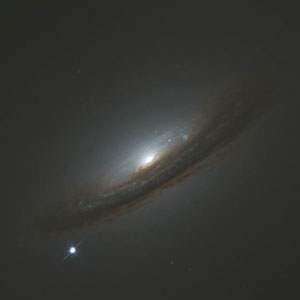Faster Walk on the Dark Side

Image credit: NASA/ESA, The Hubble Key Project Team and The High-Z Supernova Search Team
A type Ia supernova (lower left) occurred in NGC 4526.
There is new evidence that a mysterious anti-gravity energy is speeding up the expansion of the universe. This energy is called dark energy and makes up almost three-quarters of the universe. All that we know about this dark energy is that it works against gravity and causes galaxies to move apart faster than expected.
The new evidence is the discovery of an effect dark en-ergy has on light from the earliest universe. This very old light started its journey across the universe just 380,000 years after the Big Bang. Its energy has cooled down to microwave energy in the 13 billion years since. Today we observe the light as cosmic microwave background (CMB) radiation. Scientists noticed something called the Integrated Sachs-Wolfe (ISW) effect acting on the CMB.
ISW was named after Rainer Kurt Sachs and Arthur Michael Wolfe, who first described it in in 1967. Its effect on the CMB was recently confirmed by scientists around the world. The three teams who did the work were Stephen Boughn of Haverford College, Robert Crittenden of the University of Portsmouth and the WMAP team led by NASA's Charles Bennett. Helping Bennett were astronomers of the Sloan Digital Sky Survey team who worked with Pablo Fosalba of the Institut d'Astrophysique de Paris and his coworkers.
These scientists pulled together valuable data on the large-scale structures of the universe and data on light from the early universe (CMB) to reach their conclusions. The data included observations from visible light, X-ray, radio and microwave telescopes.
Here's how the ISW effect works. Gravity is a property of matter. Matter exists in "gravity wells" in space-time. More matter makes a deeper well. If there is no change in the depth of a well when light crosses it, then the well has no effect on the energy of the light. If dark energy stretches out deep wells of gravity into shallow dents, then CMB light crossing the well will change its energy. The data collected by these scientists show slight changes in the energy, which provides evidence of dark energy.

Image credit: NASA's Cosmic Times
Illustration of the Integrated Sachs-Wolfe effect.
This is good news to two teams of astronomers who discovered the first signs of dark energy in 1998. They discovered galaxies were moving faster than they should be. They learned this by measuring the speed at which very distant Type Ia supernovae (in the galaxies) moved away from our galaxy, The teams were the Supernova Cosmology Project team at Lawrence Berkeley National Lab and the International High-z Supernova Search Team. They meant to measure the rate at which the expansion of the universe was slowing down. Instead, the supernovae showed the distance between Earth and the most distant galaxies was growing faster and faster. It was like some unknown invisible force of "dark" energy was working against the force of gravity and pushing galaxies apart. More than that, the expansion sped up five billion years ago.
The researchers chose to name this force dark energy. This should not be confused with dark matter, which is another puzzling problem in cosmology.
As for what dark energy is, that's anyone's guess right now. There are at least half dozen theories, and none of them seem very close to an answer. •



